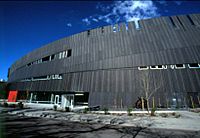Nevada Museum of Art facts for kids
 |
|
| Established | 1931 |
|---|---|
| Location | Reno, Nevada |
| Type | Art museum |
| Collection size | 1900 |
The Nevada Museum of Art is a cool art museum located in Reno, Nevada. You can find it at 160 West Liberty Street. It's the only art museum in Nevada that has been officially recognized by the American Alliance of Museums. This means it meets high standards! The museum loves to show art that focuses on how people connect with the land and how important it is to protect nature. In 2003, the museum moved into a brand new building. It was designed by a famous architect named Will Bruder.
Contents
Discover the Art Collections
The museum has a huge collection of art, with more than 2,000 pieces! These artworks are from the 1800s all the way up to today. The collection is split into four main areas. Each area explores how humans interact with their natural world, the buildings around them, and even digital spaces. Instead of just showing art by date or style, the museum groups art by these interesting themes. This helps you see different ways artists think about our environment.
Modern Art Today
The museum's collection of modern art is growing fast! It features amazing works by artists from all over the world. You'll see paintings, drawings, photos, sculptures, and even digital art. These pieces are made by artists who are alive today. They help us see modern society in new and exciting ways. The museum looks for art that shows how artists creatively interact with nature, cities, and even virtual worlds. Some well-known artists in this collection include Tim Hawkinson, Andrea Zittel, Petah Coyne, and Lordy Rodriguez.
The Altered Landscape: Carol Franc Buck Collection
This is the museum's biggest collection! It's full of modern landscape photographs. Since the early 1990s, this collection has focused on showing how we use land and how landscapes are changing. The photos are by many different artists and use various styles. But they all share two main ideas:
- They want people to talk about how human actions affect nature.
- They move away from the old idea of perfect, untouched nature.
In 1998, the Carol Franc Buck Foundation helped create a special fund to buy more photos for this collection. In 2011, a big book about The Altered Landscape was published. It won an award in 2012 for being one of the best art museum books in the United States. The book has 150 images by 100 photographers. These were chosen from over 900 photos the museum has collected since the 1970s.
Art of the Greater West Collection
This collection is named after Robert S. and Dorothy J. Keyser. It looks at art from a very wide "West." This includes areas from Alaska all the way down to Patagonia (in South America). It also covers places from Australia to the western United States. While it started with art from the Sierra Nevada and Great Basin areas, new artworks connect different cultures and art styles from this huge Western region.
The E.L. Wiegand Collection
This collection focuses on the idea of "work" in American art. It includes paintings that show different kinds of jobs, workers, or workplaces. Some famous artists in this collection are Carl Oscar Borg, Lorser Feitelson, Lovell Birge Harrison, Helen Lundeberg, Guy Pène du Bois, and even Grandma Moses.
Center for Art + Environment
The Center for Art + Environment was started in 2009. It's a special part of the museum that studies how people interact with nature, buildings, and digital spaces. This center is like the museum's research department. Its archives hold over 50 collections with 12,000 items! These items represent work from more than 500 artists from all seven continents.
Important archives include materials from artists who create "Earthworks," like Michael Heizer, Walter De Maria, and Lita Albuquerque. It also has work from environmental architects and ongoing projects from groups like the Center for Land Use Interpretation. The CA+E is the only research center in the world dedicated to studying art and the environment.
The Center for Art + Environment also hosts a big conference every three years called the Art + Environment Conference. Many artists, thinkers, and experts from around the world come to share their ideas.
Scholastic Art Awards
The museum helps young artists by taking part in the Scholastic Art Awards program. This program gives high school students from northern Nevada a chance to show their artwork in a real museum! The museum also has a newly updated art school called the E.L. Cord museum school. It offers different art classes to help students and teachers improve their art skills.

